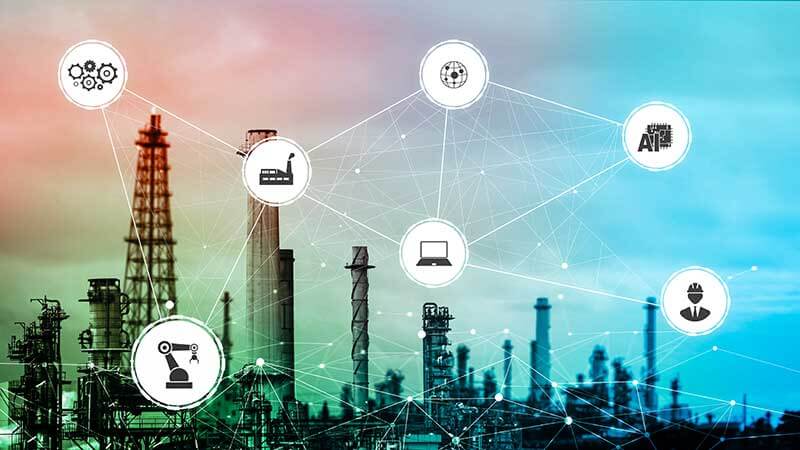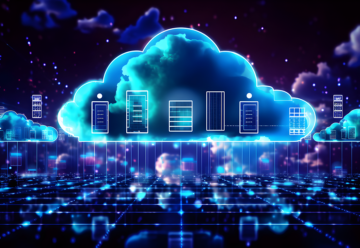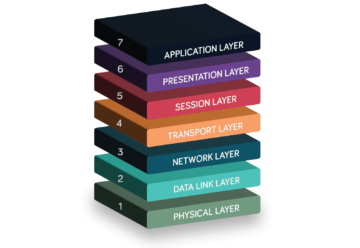- Home
- Resources
- Blog
- Home
- Business General
- What is the Fourth Industrial Revolution (4IR)?
What is the Fourth Industrial Revolution (4IR)?
We’re living in a transformative age. Learn about the new technologies driving change, their impacts and challenges, and how to adapt to this new world.
- Neos Networks
- Business General ,

- What is the Fourth Industrial Revolution (4IR)?
- Ten technologies driving 4IR
- Impacts of 4IR
- Challenges of 4IR
- Adapting to 4IR
What is the Fourth Industrial Revolution (4IR)?
The Fourth Industrial Revolution, also known as 4IR or Industry 4.0, refers to the rapid technological advancements of this century – emerging technologies like artificial intelligence (AI), robotics, the Internet of Things (IoT) and biotechnology. The current unprecedented speed of breakthroughs, the disruption caused to almost every industry worldwide, and their potential to transform the global economy and society make this a new industrial revolution.
The first industrial revolution was powered by steam and water in the 18th and 19th centuries. Electricity powered the second revolution. Computers and the internet fuelled a third, digital revolution in the last century. Today, the rise of intelligent machines is driving the fourth revolution, transforming how we live, work and play.
Fourth Industrial Revolution timeline

As in previous industrial revolutions, 4IR is fuelled by a combination of emerging industries building on each other.
Ten technologies driving 4IR
The Fourth Industrial Revolution is often described as a fusion of technologies that merge the digital, physical and biological worlds.
By embedding sensors and connectivity into objects, including our bodies, we’re finding new ways to communicate with machines and enhance human capabilities. Here are some of the key technologies driving the revolution.
1. AI and Machine Learning
Artificial intelligence (AI) is a set of technologies that can reason and learn to solve problems or perform tasks that traditionally require human intelligence. It powers innovations like autonomous vehicles, advanced healthcare diagnostics and personalised customer experiences.
2. Big Data and analytics
A significant underlying driver of the revolution, Big Data and analytics refers to collecting and analysing vast volumes of data to reveal trends and insights. Big Data is improving operational efficiencies and changing decision-making in business and wider society.
3. IoT
The Internet of Things (IoT) refers to the network of interconnected devices that exchange data over the internet. A key 4IR technology, IoT enables advances like industrial automation, smart homes and real-time health monitoring.
4. Cloud computing
Cloud computing is the on-demand delivery of computing services like apps, storage and networking over the internet. Cloud services allow businesses to rapidly innovate and scale operations without investing in their infrastructure.
5. Robotics and automation
Advanced robotics enables sophisticated robots, including humanoid assistants, to perform complex high-precision tasks independently with high precision. These robots can play vital roles in manufacturing, healthcare and customer service, often enhancing productivity and safety.
6. AR and VR
Augmented reality (AR) overlays digital images on the world around you. In contrast, virtual reality (VR) creates an alternative, computer-generated environment that you interact with. These technologies are set to provide immersive experiences for education, remote collaboration and customer service.
7. Biotech and nanotech
Biotechnology uses living organisms, or their derivatives, to develop products or technologies. Today, rapid advances in fields such as genetic engineering, biopharmaceuticals and agricultural biotech are leading to breakthroughs in medicine and food production. And nanotechnology, manipulating materials at a molecular level, creates new materials for medicine and engineering.
8. Quantum computing
Using the principles of quantum mechanics, quantum computers can operate at exponentially faster speeds than traditional computers. This enables us to solve complex problems in fields like material science and cryptography.
9. Blockchain
Blockchain is a decentralised ledger technology that ensures transactions aren’t tampered with. Underpinning cryptocurrencies like Bitcoin, blockchain is also used for digital ID verification, smart contracts and supply chain management.
10. 3D printing
3D printing uses computer-aided design to create three-dimensional objects by layering materials like plastics, composites or biomaterials. Also known as additive manufacturing, 3D printing revolutionises production by enabling rapid prototyping and customised manufacturing, reducing waste and costs.
Overall, these technologies represent a revolution due to their exponential growth and potentially profound impact on our lives.
Impacts of the Fourth Industrial Revolution
As 4IR technologies advance, they’re expected to transform the economy, society, government and environment of countries worldwide.
Economy
First, integrating tech like AI, robotics and automation enables businesses to boost productivity and efficiency. This can lead to higher production, faster product innovation, enhanced customer service and reduced costs.
Second, 4IR is set to drive innovation in products and services, transforming existing industries or creating new business models. Advanced manufacturing techniques will allow greater personalisation of products and services.
Third, these technologies are set to displace some traditional manufacturing and routine white-collar jobs. However, they’ll also create new jobs in high-tech industries, data analysis and cybersecurity.
Society
To meet the demands of this new economy, education will have to adapt. Schools and higher education must focus on STEM education and lifelong learning to enable individuals for future jobs.
All the more so because we’ll live longer. Advances in health care, personalised medicine and smart infrastructure will likely improve older people's life expectancy and quality of life.
In addition, the proliferation of internet-connected mobile devices and the rise of IoT gives us unprecedented connectivity. This enables near real-time data exchange globally, fostering collaboration and competition.
However, access to advanced technologies varies across communities and countries. Owners and investors in new technologies are poised to gain significant wealth. As a result, the rapid pace of technological change could exacerbate existing wealth and digital divides.
Government
Governments will have new ways of interacting with citizens to address these challenges. For example, e-government services and smart cities are already used in the UK to enhance public services.
On the other hand, emerging technologies can threaten fundamental freedoms. Across the globe, dictators find new ways to monitor and control their populations. And rapidly evolving technological innovation increases the risk of war and the means to wage it.
Environment
On the positive side, renewable energy, smart manufacturing and new sustainable practices can mitigate environmental impacts. Together with new technologies like carbon emissions management, they can help us tackle climate change.
Yet the increase in energy consumption from AI and cloud computing, electronic waste and the depletion of resources could degrade the environment if not managed properly – one of several challenges the revolution poses.
Challenges of the Fourth Industrial Revolution
While 4IR is set to bring enormous benefits, its blurring of the digital, physical and biological spheres entails several risks. Here are some key challenges.
First, the data explosion fuelled by industries like cloud computing, AI, and IoT raises data privacy and security concerns. In a hyperconnected world, how can we protect user privacy? How can we defend complex, interconnected systems against cyberattacks?
Second, the rapid rise of AI, genetic engineering, biotech, autonomous vehicles and robots pose thorny ethical questions. For example, how can we remove bias from AI decision-making? How can we control biohacking and prevent designer babies? How can we stop autonomous robots from getting out of control?
Third, the socioeconomic impacts above could lead to income inequalities, business bankruptcies, unemployment and even social unrest. How can governments and individuals adapt?
Overall, how can we effectively regulate 4IR technologies? The regulation of new technology often fails to keep up with the pace of innovation, and rules and enforcement differ around the world.
Adapting to the Fourth Industrial Revolution
Meeting the challenges of 4IR will require collective, global efforts across various industries.
First, governments should work with businesses, academia and wider society to regulate new fields like AI and biotechnology. We need timely international regulation of 4IR technologies to promote their benefits while mitigating risks.
As individuals, we need to get used to flexible careers and continuous learning. With the rapid pace of change, education will likely become a lifelong process as we adapt to evolving tech.
For businesses, new technologies mean new opportunities and new threats. To meet these challenges, companies will need to:
- Prioritise digital transformation: Invest in digital infrastructure and technologies like AI and IoT to enhance products, operational efficiency and customer service.
- Train employees: Provide continuous learning for staff to work with evolving technologies.
- Adopt Agile working: Introduce methodologies to enhance flexibility and foster a culture of innovation.
- Improve data management: Collect and analyse data to improve business insights and decision-making.
- Bolster cybersecurity: Protect sensitive data from increasing cyber threats.
We can’t predict the future, but one thing seems certain: connectivity will be crucial to compete in this new world.
At Neos Networks, we deliver scalable, high capacity connectivity for UK businesses nationwide. If you’re looking to connect your business for the future, contact us. We’ll be happy to design a network for your business, however the revolution unfolds.
You might also like

Discover our network reach
We can connect you anywhere in the UK
Great news!
"[poscode]" can be reached with our
expanded network
Speak to a representatitive to discuss your options
Contact usLearn about our prices using our online tool, LIVEQUOTE
View LIVEQUOTESorry
"[poscode]" can not be reached with our
expanded network
Speak to a representatitive to discuss your options
Contact usLearn about our prices using our online tool, LIVEQUOTE
View LIVEQUOTE



